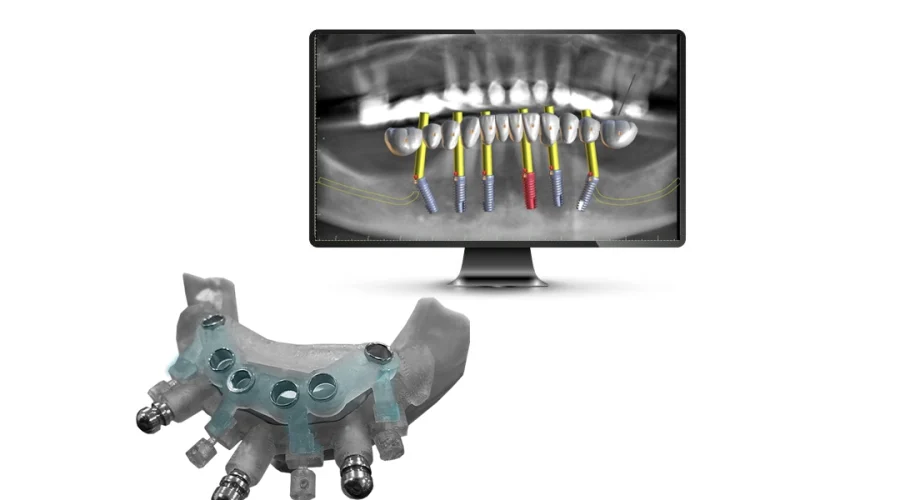The latest edition in digital dentistry, Guided Implant Surgeries (GIS) is the new favorite among dentists for its enhanced accuracy, faster healing time, and minimally invasive surgery option.
Originally developed for Neurosurgery, computer-guided surgeries provide ample benefits to dental surgeons and patients.
In this article, we will discuss the benefits and advantages of guided implant surgeries.
Advantages of Guided Implant Dentistry
1. Better Accuracy:
The guided implant surgery procedure involves new and improved 3D imaging technologies, such as cone beam computed tomography (CBCT) scans and intraoral scanners, to create detailed 3D models of a patient’s oral anatomy. These digital images are necessary for precise implant placement planning, including factors like bone density, anatomical structures, and aesthetics. Using the latest technologies for depth, angle, and precise position involves minimum risk of errors and ensures better outcomes.
2. Increased Predictability:
Using computer-aided (CAD) software, dental professionals can easily predict potential challenges and devise solutions. By reducing the complications during surgery, this approach increases the potential for the long-term success of dental implants.
3. Shorter Treatment Time:
One of the biggest achievements of any technological advancement is to reduce the operation time. Similarly, guided implant surgeries reduce treatment time over traditional implant surgeries. With precise planning and implant placement, dentists perform surgeries more efficiently. Also, CAD/CAM technology enables the curating of precise custom implant restorations. The whole point is to minimize the treatment time and enable fast and timely delivery of prostheses to patients.
4. Enhanced Patient Care & Comfort:
Another important aspect of guided implant surgery is that it offers an improved patient experience compared to conventional implant procedures. The guided and précised planning of the whole process leads to a better and smoother surgical experience for both the professionals and patients. Advanced planning and predictable results channel the exact depth, angle, and placement with a controlled activity, minimizing patient discomfort that leads to less pain, swelling, and downtime.
5. Ideal & Suitable Outcomes:
One of the primary goals of dental implant treatment is to achieve genuine or natural-looking aesthetics. The technology involves less time, and the guided and controlled atmosphere ensures optimal aesthetic outcomes for the patients. By positioning the implant at the right place relative to the surrounding teeth and soft tissues, dentists can achieve harmonious integration with the patient’s natural smile, resulting in a lifelike aesthetic outcome.
6. Communication within the Dental Community:
Guided implant dentistry provides a unique opportunity to nurture professional communication among the dental team of dentists, oral surgeons, prosthodontists and dental expert partners. Dental professionals can coordinate and collaborate within the team for an enhanced experience using digital planning software and virtual implant placement simulations.
7. Long-term stability:
Guided implant dentistry ensures dental implants’ long-term stability and functionality. The guided placement of implants and optimal osseointegration help enhance the prolonged outcome of the implant-supported restoration, providing the patients with quality of life and well-being. They can enjoy normal teeth functioning, including chewing food, clear speech and overall health for a long time.
8. Assists in the placement of additional implants:
Computer-guided surgery may also be advantageous for patients who already have dental implants. It allows for the accurate placement of existing implants, guaranteeing that subsequent implants are placed in the best possible sites.
Conclusion
The main benefits of computer-guided surgery involving digital planning software include precise and accurate implant placement. The ability to visualize vital anatomical structures allows professionals to preserve them during guided surgery. It’s less invasive, cost-effective, increases the dental implant success rate, and provides great results in less time compared to traditional implant surgeries.
Guided implant surgery may be the best option if you want a safe, accurate, and predictable solution to tooth loss.
Visit our website for more information and guidance on guided implant surgery and training.
FAQs
Guided implant surgery may be a bit more expensive than traditional implant placement due to the additional technology and guide manufacturing involved. However, the precision, reduced risk of complications, and faster recovery may ultimately result in cost savings in the long term.
The surgical guides prevent the implants from being placed too deep, shallow, or wrong. Accurate placement and reduced injury or trauma to surrounding tissues result in less pain and quicker recovery than traditional implant placements.
This is because of the technologies involved. Guided implant surgery eliminates guesswork and is much more accurate than older techniques. With a 3D model of your mouth, the dentist can accurately and clearly visualize each step of the procedure, minimizing surgical risks and complications and lesser trauma to the surrounding tissues.
One potential drawback of guided implant surgery is it is a costlier option than the traditional methods.




